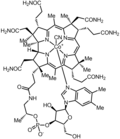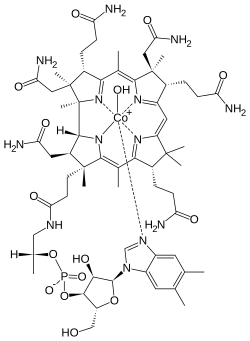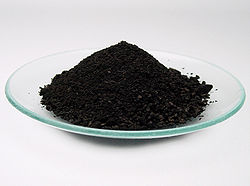Cobalt(II) cyanide is the inorganic compound with the formula Co(CN)2. It is coordination polymer that has attracted intermittent attention over many years...
4 KB (311 words) - 19:23, 25 September 2023
pigment is cobalt(II) oxide-aluminium oxide, or cobalt(II) aluminate, CoAl2O4. Cobalt blue is lighter and less intense than the (iron-cyanide based) pigment...
10 KB (997 words) - 23:24, 1 May 2025
Iron(II) cyanide is an inorganic compound with the empirical formula Fe(CN)2. It may have a Fe2[Fe(CN)6] structure.[better source needed] Iron(II) cyanide...
2 KB (110 words) - 18:03, 2 December 2023
Ionic cyanides contain the cyanide anion −C≡N. This anion is extremely poisonous. Soluble cyanide salts such as sodium cyanide (NaCN), potassium cyanide (KCN)...
36 KB (3,966 words) - 04:29, 17 April 2025
to treat and prevent vitamin B 12 deficiency except in the presence of cyanide toxicity. The deficiency may occur in pernicious anemia, following surgical...
30 KB (2,673 words) - 13:58, 10 April 2025
Thiocyanate (section Test for iron(III) and cobalt(II))
Thiocyanate is produced by the reaction of elemental sulfur or thiosulfate with cyanide: 8 CN− + S8 → 8 SCN− CN− + S2O2−3 → SCN− + SO2−3 The second reaction is...
15 KB (1,487 words) - 17:56, 2 February 2025
Corrinoid (section Reactions with cyanide)
cobalamin or cobinamide, reacts with free cyanide in an aqueous sample. The binding of cyanide to the corrinoid cobalt center leads to a color change from orange...
5 KB (534 words) - 16:09, 18 December 2024
Cyanometalate (redirect from Metal cyanide complex)
produced by the addition of five or more equivalents of a cyanide to a solution of a cobalt(II) salt. It is square pyramidal. Solutions of [Co(CN)5]−3 undergo...
16 KB (1,431 words) - 19:14, 22 May 2025
7789-43-7 Co(CN)2 cobalt(II) cyanide 542-84-7 Co(C2H3O2)2 cobalt(II) acetate 71-48-7 Co(C2H3O2)3 cobalt(III) acetate 917-69-1 CoC2O4 cobalt(II) oxalate 814-89-1...
183 KB (107 words) - 23:35, 7 May 2025
Vitamin B12 (category Cobalt(II) compounds)
intravenously for the purpose of treating cyanide poisoning, as the hydroxyl group is displaced by cyanide, creating a non-toxic cyanocobalamin that is...
110 KB (11,943 words) - 17:24, 17 May 2025
Dicobalt edetate (category Cobalt compounds)
each of which is kinetically labile and has a high affinity for cyanide. Oxidation of [Co(II)(EDTA)]2− gives [Co(III)(EDTA)]−, which is so kinetically inert...
4 KB (349 words) - 01:20, 2 September 2023
Dicobalt octacarbonyl (redirect from Cobalt carbonyl)
carbonylation of cobalt(II) salts: 2 (CH3COO)2Co + 8 CO + 2 H2 → Co2(CO)8 + 4 CH3COOH The preparation is often carried out in the presence of cyanide, converting...
20 KB (1,682 words) - 20:15, 23 April 2025
Nickel dicyanide (redirect from Nickel(II) cyanide)
sodium or potassium cyanide to a solution of nickel(II) ions in aqueous solution leads to the precipitation of nickel(II) cyanide tetrahydrate. On heating...
4 KB (270 words) - 20:59, 23 September 2023
Cobalt poisoning is intoxication caused by excessive levels of cobalt in the body. Cobalt is an essential element for health in animals in minute amounts...
7 KB (764 words) - 20:41, 26 December 2024
Pentacyanocobaltate (category Cobalt(II) compounds)
or more equivalents of a cyanide salt to a solution of a cobalt(II) salt. Initially this reaction produces insoluble cobalt dicyanide, but this solid...
3 KB (335 words) - 10:38, 28 June 2024
13820–62–7 CoBr2 cobalt(II) bromide 7789–43–7 Co(CN)2 cobalt(II) cyanide 542–84–7 Co(C2H3O2)2 cobalt(II) acetate 71–48–7 Co(C2H3O2)2 cobalt(II) acetate tetrahydrate...
139 KB (120 words) - 17:15, 19 May 2025
bonded to the metal. Typical ligands that give rise to linkage isomers are: cyanide, CN− – isocyanide, NC− cyanate, OCN− – isocyanate, NCO− thiocyanate, SCN−...
3 KB (364 words) - 19:31, 22 February 2025
Hydroxocobalamin (section Cyanide poisoning)
"Comparison of the hemodynamic effects of hydroxocobalamin and cobalt edetate at equipotent cyanide antidotal doses in conscious dogs". Intensive Care Medicine...
21 KB (2,027 words) - 00:06, 8 February 2025
Group 9 element (redirect from Cobalt family)
wear-resistant and high-strength alloys. The compounds cobalt silicate and cobalt(II) aluminate (CoAl2O4, cobalt blue) give a distinctive deep blue color to glass...
21 KB (2,226 words) - 01:50, 21 March 2025
Prussian blue (redirect from Iron(II,III) hexacyanoferrate(II,III))
to prussic acid (hydrogen cyanide) derived from it. In German, hydrogen cyanide is called Blausäure ('blue acid'). Cyanide also acquired its name from...
45 KB (4,960 words) - 11:21, 22 May 2025
fluoride – CrO2F2 Cobalt(II) acetate – Co(CH3CO2)2 Cobalt(II) bromide – CoBr2 Cobalt(II) carbonate – CoCO3 Cobalt(II) chloride – CoCl2 Cobalt(II) fluoride –...
121 KB (8,924 words) - 00:00, 18 May 2025
triphenylphosphine), iodide, and cyanide as well as some tertiary amines induce reduction to give copper(I) complexes. Copper(II) chloride is prepared commercially...
30 KB (2,743 words) - 19:48, 20 January 2025
8(AlSiO 4) 6(S,SO 4,Cl) 1–2. Cobalt pigments Cobalt blue (PB28): cobalt(II) aluminate. Cerulean blue (PB35): cobalt(II) stannate. Cerium uranium blue...
10 KB (863 words) - 11:57, 17 May 2025
Blue pigments (section Cobalt blue)
constituent of the pigment is cobalt(II) stannate (Co 2SnO 4). Cerulean blue Jour d'été (Summer's Day) (1879) Berthe Morisot Cobalt blue La Yole (Boating on...
18 KB (2,082 words) - 19:46, 2 February 2025
is poisonous, unlike the iron(II) complex [Fe(CN)6]4− found in Prussian blue, which does not release hydrogen cyanide except when dilute acids are added...
25 KB (2,753 words) - 05:16, 4 April 2025
Muthukumaran; H. V. K. Udupa (1979). "The electroreduction of benzyl cyanide on iron and cobalt cathodes". Journal of Applied Electrochemistry. 9 (5): 657–659...
7 KB (738 words) - 21:47, 29 July 2022
Chloro(pyridine)cobaloxime (category Cobalt complexes)
8 py + O2 → 4 ClCo(dmgH)2py + 4 py•HCl + 14 H2O Using cobalt(II) acetate in place of cobalt(II) chloride produce aceto(pyridine)cobaloxime. This acetate...
7 KB (616 words) - 07:09, 30 July 2024
based on the basic building blocks ammonia, formaldehyde and hydrogen cyanide, which are reacted (via the triple cyanomethylation of the ammonia) in...
10 KB (1,007 words) - 12:41, 23 July 2024
3-ethoxypropionitrile, an ether, with oxygen under pressure in the presence of cobalt(II) acetate tetrahydrate as catalyst and N-hydroxyphthalimide as a radical...
9 KB (990 words) - 15:31, 24 March 2025
Iron(II) oxide or ferrous oxide is the inorganic compound with the formula FeO. Its mineral form is known as wüstite. One of several iron oxides, it is...
7 KB (549 words) - 18:05, 6 March 2025


















